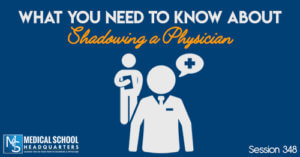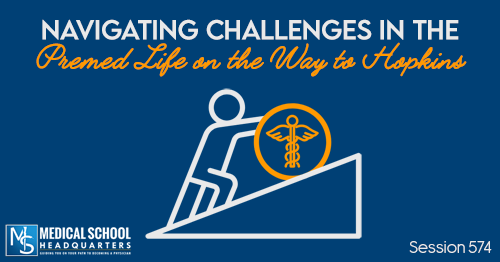Apple Podcasts | Google Podcasts

Session 348
Dr. Elaine Reno is a professor of emergency medicine and mentor. She has put hundreds and hundreds of students through shadowing experiences – both good and bad. Today, we talk about what makes good shadowing and what makes bad shadowing. Basically, we cover all things shadowing, from finding opportunities, to saying “thank you”!
If you haven’t yet, please check out all our other podcasts on Meded Media as you’re journeying through this road to medical school. We are actively finding physicians that we can add to our database over at FindShadowing.com to help students as they’re looking for physicians to shadow.
Listen to this podcast episode with the player above, or keep reading for the highlights and takeaway points.
[03:08] A Little Background About Dr. Elaine Reno
Serving as a faculty at the University of Colorado, she runs a Wilderness Medicine Course for undergraduates interested in healthcare-related careers. Students are given the chance to spend time at the campus, doing interviews and attending career panels. They also get to spend a week in the mountains as they learn about wilderness first aid.
This program is offered to those who want to go into healthcare-related careers. They’ve had nursing students take it as well as those interested in PA school and medical school. It somewhat serves as a next step in the evolution of your career if you’re still deciding what you want to do next.
They also have a program outside of Colorado including Costa Rica and the Channel Islands.
[05:45] How to Find Someone to Shadow – Tip #1: Ask Your Personal Doctor
The most basic way is to ask your personal doctor if you can shadow them. Or you can ask whether they have colleagues that may allow you to shadow.
'The very most basic is you can ask your own physician if they have ideas about shadowing.'Click To TweetDon’t make your doctor’s visit to solely discuss shadowing. Although if you’re really there for a doctor’s visit, then you could bring it up. Another way is to call the office and ask the office manager about your plan to ask to shadow your physician. Then ask for a better time for you to call so you can discuss it.
[Related episode: How To Effectively Shadow a Doctor as a Premed]
[07:20] How to Find Someone to Shadow – Tip #2: Reach Out to Your Broader Social Circle
Reach out to your broader social circle. This includes your family, friends, and mentors. Ask them if they know of any shadowing opportunities. But all of those rely on personal contacts.
But let’s assume you have never met a doctor in your entire life or no one you know knows a doctor. In this case, look for volunteering opportunities.
[Related episode: Does Shadowing a Family Member Look Bad?]
[08:40] How to Find Someone to Shadow – Tip #3: Volunteering
Look for volunteering opportunities. This will allow you to meet people and make connections to identify for shadowing opportunities.
People think they can only volunteer at big hospitals but you can actually look for more community-based volunteering opportunities in medicine. If there’s a local clinic near you that has a lot of kids, check to see if you can volunteer there.
'Be creative about where you can volunteer. The last thing you want to do is have some volunteer opportunity where you're just sitting there and no one has any real task for you.'Click To TweetElaine also stresses the importance of being creative when looking for shadowing opportunities. You don’t want to be volunteering at someplace where you don’t have any task and you’re just there to check off the boxes of your CV. This isn’t a good use of your time.
[Related episode: Premed Clinical Experience: Shadowing & Volunteering]
[10:20] How to Find Someone to Shadow – Tip #4: Paid Jobs
There are a lot of paid opportunities for undergraduate students including working as a scribe. Scribes hang out and do documentation. Scribing is also counted as shadowing since you get to follow the physician everywhere they go.
But how do you categorize scribing in your application? Technically, scribing is considered clinical experience, not shadowing. But to a lot of medical schools, especially if you lack shadowing but you have a lot of scribe experience, then this can be mixed up for the lack of “shadowing.”
Since scribing gives you the chance to meet physicians, you get to connect with other doctors. You can then use that connection to create shadowing opportunities.
Other paid jobs include EMS, office billing, a reception medical office or medical assistant. This can fall under paid clinical opportunities. Again, you get to meet people who can connect you to others and provide shadowing opportunities.
[12:17] How to Find Someone to Shadow – Tip #5: Research Opportunities
Try to find research opportunities with exposure to clinical care. A clinical research coordinator is an amazing job where you get to have significant shadowing opportunity.
For example, Elaine worked as a research assistant before going to medical school. One of her jobs was to go into the operating room and collect the primary tumor samples. She then got to witness surgeons taking a portion of the tumor inside the operating room.
In this scenario, you can split this up in your application for research and shadowing. A part of your time is spent sitting in the room and watching a physician do their thing.
[Related episode: Is Research More Important than Clinical Experience?]
[15:00] Shadowing Responsibilities
Shadowing can add extra work to the physician that’s why there are some who don’t like to have people shadowing them. Elaine underlines two responsibilities here.
As a practicing physician in a medical school setting, Elaine feels having this ethical responsibility to the next generation. On the other hand, students also have the responsibility to the patient the doctor is caring for. They have to do it in an ethical, appropriate manner and as unintrusive as possible.
Being in an academic setting, patients are used to a team-based approach so they’re used to having lots of people involved in their care.
When Elaine takes students shadowing her, she walks into the room first. Then she asks permission from the patients if they’re comfortable having students watching them. 90% of the time, they say yes. And if they’re not okay with it, she’d just ask the students to leave the room.
But she doesn’t do this for very sensitive cases like dealing with breasts or the genitals, or cases involving domestic abuse, child assault, psychiatric illness, etc. If she doesn’t think a patient feel comfortable discussing in a big group setting then she wouldn’t bring any of the students inside the room.
[18:50] The Do’s and Don’ts When Doing Cold Outreach
If there’s some type of connection, the person who is the connection point between the two of you can send an introductory email.
And once you follow up to that email, the next step is to write it short, to the point, polite, and respectful.
'You should always refer to them as 'Doctor.' You are not on a first-name basis with them, and even if you are, if it's in formal communication refer to them as Doctor.'Click To TweetState your purpose in one paragraph. Then give them contact information in the end along with your attached CV. Do not send it in the text of the email but as an attachment.
Make sure your CV is polished as you’re sending out to the world as a marker of yourself. Then thank the physician for taking the time to read your email.
It’s reasonable to send one follow-up email. Make it really quick and short. And if you don’t get anything back, then just drop it.
'The last thing you want to do is annoy someone or burn bridges. There's a lot of people out there to shadow. Sometimes, you have to let some of the opportunities pass you by.'Click To TweetIf you’re trying to reach out to someone wherein you don’t have any connection with, start with clinics.
Start looking around places known for education. If you can get someone’s email address, just pick two or three. Research what specific things they do. Start with specialties like Family Medicine as this may be a better setting to start with.
Write one paragraph about you and ask them if they’re open to having shadowing students. Again, don’t forget to thank them for taking the time to read your email. Then attach your CV.
'Make it short, polite, to the point, without being too aggressive.'Click To Tweet[26:40] Tips for First-Timers
- Do all the required stuff upfront. For students who shadow Elaine, they have to undergo HIPAA training through the volunteer office. Otherwise, she’d tell you to go home and you’re done.
- Make sure you’re fed and hydrated because the last thing you want to do is pass out.
- Dress appropriately. Come in business professional attire, not shorts or scrubs. A lot of hospitals have rules about scrubs like certain colors need to be in certain areas.
For men, Elaine recommends wearing a shirt and tie, colored, long-sleeved, and long pants with a belt.
For women, Elaine doesn’t recommend heels since you’ll be moving fast so you want to be able to walk. If you’re going to wear a skirt, it needs to hit below your knees.
'You want to be polished, presentable, and conservative.'Click To Tweet- Don’t use your phones. There are specific rules on phones in healthcare settings but your phone should just be off. Don’t take pictures. You don’t need to be on Instagram or Facebook.
- Notetaking is not allowed in a lot of healthcare settings for shadowers to take notes. So just don’t do it because there’s a concern for HIPAA violation there.
[34:50] When to Ask Questions
This usually involves timing and reading what’s going on in the room. That said, there are bad times to ask questions like when the team is really busy or something is happening. This is the time to store up questions in your brain.
A possible time you can ask questions is during downtime or a coffee break. A lot of times, it’s about reading the room and what’s going on. However, most of the time, they’re really busy and there’s no time to ask questions.
Setting the ground is fine. You can ask the physician how you can identify a good opportunity to ask questions.
[37:25] Saying Thank You and Journaling
If you so desperately want to give a gift, don’t give it directly to a physician. Send them to the office.
The best way is to email the physician and say thank you for providing you the opportunity to shadow. Again, make it short.
Journal around your own personal experiences. You are allowed to have a reflection moment and jot down some thoughts. Write about how the experience has inspired you to pursue healthcare or relinquish your decision.
[40:25] Asking for a Second Time or a Letter of Recommendation
You can say something along the lines of letting you know should there be any shadowing opportunities.
One day of shadowing is NOT going to give you a good letter of recommendation.
'Getting letters of recommendation is one of the hardest possible things that premeds do.'Click To TweetFinally, Elaine leaves us with some last pieces of advice. Try not to piss anyone off. Make sure you’re on time. Be polite and be prepared. Pack snacks. And if you’re in a setting where you think you can wear scrubs, still dress business casual and pack scrubs.
[Related episode: How Soon Can I Ask for a Letter of Recommendation?]
Links:
Check out our previous episode with Dr. Elaine Reno on Episode 279
Wilderness Medicine Course (To know more about the Wilderness Medicine Program, text WILDMED to 44222 and get a link right on your phone.)











